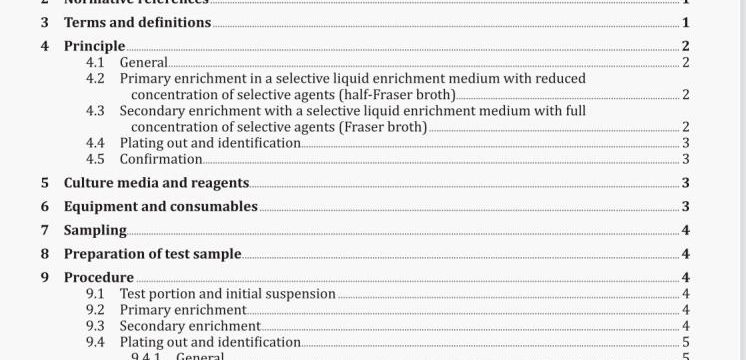Microbiology of the food chain — Horizontal method for the detection and enumeration of Listeria monocyto genes and of Listeria spp.
AS 5013.24.1-2020 pdf download.Food microbiology
Method 24.1: Microbiology of the food chain — Horizontal method for the detection and enumeration of Listeria monocyto genes and of Listeria spp. — Detection method.
9.4.1.1 From the primary enrichment culture (9.2) incubated for 25 h ± 1 h at 30 °C (6.3), inoculate. by means of a loop (6.5), the surface of the first selective plating medium, Agar Listeria according to Ottaviani and Agosti (B.3), to obtain well-separated colonies.
Proceed in the same way with the second selective plating-out medium of choice (8.4).
NOTE Half-Fraser broth and Fraser broth can be refrigerated at 5 °C (6.10) before isolation on selective agar for a maximum of 72 h.1201
9.4.1.2 From the secondary enrichment medium incubated for 24 h ± 2 h at 37 °C (6.3) (9.3.2), repeat the procedure described in 9.4.1.1 with the two selective plating-out media.
9.4.1.3 Invert the Petri dishes obtained in 9.4.1.1 and 9.4.1.2 and place them in an incubator set at
37°C (6.3) for Agar Listeria according to Ottaviani and Agosti (B.3). For the second selective medium (8.4), follow the manufacturer’s instructions.
9.4.1.4 For Agar Listeria according to Ottaviani and Agosti incubate for a total of 48 h ± 2 ii. If colonies of presumptive L. monocytogenes or Listeria spp. are evident at 24 h ± 2 h the incubation may be stopped at this stage. For second selective agar incubate for the appropriate time. Examine the dishes (9.4.1.3) for the presence of presumptive colonies of L. monocytogenes or Listeria spp.
NOTE After incubation plates can be refrigerated at 5 °C (6.10) br a maximum of 48 h before reading.
9.4.2 Agar Llsteria according to Ottaviani and Agosti
Consider as presumptive L. monocytogenes the blue-green colonies surrounded by an opaque halo (typical colonies). Colonies of L. ivanovii are also blue-green and surrounded by an opaque halo.
Consider as presumptive Listeria spp. the blue-green colonies with or without opaque halo.
NOTE 1 Some strains of L. monocytogenes exposed to stress conditions, particularly acid stress, can show a very weak halo (or even no halo).
NOTE 2 Some rare L. monocytogenes are characterized by a slow PIPLC (phosphatidyl inositol phospholipase C) activity. Such bacteria are detected when the total duration of Incubation is more than, for example, four days. Some of these strains could be pathogenic.1131 No L. monocyrogenes strains have been described as PIPLC negative.
NOTE 3 Some organisms other than Listeria spp. can produce blue colonies on this medium. See Annex C and Reference 1231.
9.4.3 Second selective medium
9.5.1.1 For confirmation of presumptive L. monocytogenes, take at least one colony presumed to be L. monocycogenes (see 9.4.2 and 9.4.3). One confirmed isolate per sample Is sufficient. If the first colony is negative take further colonies presumed to be L. monocytogenes from selective medium (up to a maximum of five colonies from each plate of each selective medium).
Streak the selected colonies onto the surface of pre-dried plates of a non-selective agar, for example blood agar, nutrient agar, tryptone soya yeast extract agar (TSYEA) (8.14), in a manner which will allow isolated colonies to develop.
Use of blood agar for pure culture enables interpretation of haemolysis, when positive, already at that stage (see 9.5.2.5.2 and Annex D). If streaking on blood agar does not show haemolysis, then the haemolysis test shall be done by stabbing (9.5.2.5.2) or in liquid medium (9.5,2.5.3).
Place the plates in the incubator set at 37 °C (6.3) for 18 h to 24 h or until growth is satisfactory.
If the colonies arc not isolated, pick a typical L. monocytogenes colony onto another non-selective agar plate. Carry out the following tests (9.5.2) from colonies ala pure culture on the non-selective agar.
9.5.1.2 For confirmation of presumptive Listeria spp., take at least one colony presumed to be Listeria spp. (see 9.4.2 and 9.4.3). One confirmed isolate per sample is sufficient. If the first colony is negative take further colonies presumed to be Listeria spp. from selective medium (up to a maximum of five colonies from each plate of each selective medium).
For confirmation of Listeria spp. use plates of TSYEA.
Streak the selected colonies onto the surface of pre-dried plates of TSYEA (8.14), in a manner which will allow isolated colonies to develop.
Place the plates in the incubator set at 37 °C (6.3) for 18 h to 24 h or until growth is satisfactory.
Typical colonies of Listeria Spp. on TSYEA are 1 mm to 2 mm in diameter, convex, colourless and opaque with an entire edge. When the plates are held to the light (artificial or natural) at about 45 degree angle, colonies exhibit a blue-grey colour and a granular surface.
If the colonies are not isolated, pick a typical Listeria spp. colony onto another non-selective agar plate. Carry out the following tests (9.5.3) from typical colonies ala pure culture on TSYEA.
9.5.2 Confirmation of L rnonocytogenes
9.5.2.1 General
Carry out the confirmation tests for L. monocytogenes. Appropriate positive and negative control strains for each of the confirmation tests shall be used.AS 5013.24.1-2020 pdf download.
Microbiology of the food chain — Horizontal method for the detection and enumeration of Listeria monocyto genes and of Listeria spp.
